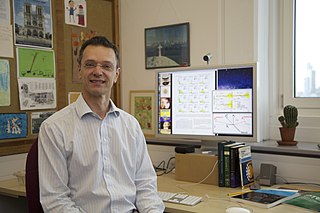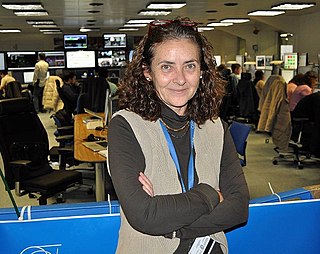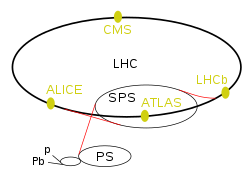
In particle physics, proton decay is a hypothetical form of particle decay in which the proton decays into lighter subatomic particles, such as a neutral pion and a positron. The proton decay hypothesis was first formulated by Andrei Sakharov in 1967. Despite significant experimental effort, proton decay has never been observed. If it does decay via a positron, the proton's half-life is constrained to be at least 1.67×1034 years.

The Large Hadron Collider (LHC) is the world's largest and highest-energy particle collider. It was built by the European Organization for Nuclear Research (CERN) between 1998 and 2008 in collaboration with over 10,000 scientists and hundreds of universities and laboratories, as well as more than 100 countries. It lies in a tunnel 27 kilometres (17 mi) in circumference and as deep as 175 metres (574 ft) beneath the France–Switzerland border near Geneva.

ATLAS is the largest general-purpose particle detector experiment at the Large Hadron Collider (LHC), a particle accelerator at CERN in Switzerland. The experiment is designed to take advantage of the unprecedented energy available at the LHC and observe phenomena that involve highly massive particles which were not observable using earlier lower-energy accelerators. ATLAS was one of the two LHC experiments involved in the discovery of the Higgs boson in July 2012. It was also designed to search for evidence of theories of particle physics beyond the Standard Model.

The CERN Axion Solar Telescope (CAST) is an experiment in astroparticle physics to search for axions originating from the Sun. The experiment, sited at CERN in Switzerland, was commissioned in 1999 and came online in 2002 with the first data-taking run starting in May 2003. The successful detection of solar axions would constitute a major discovery in particle physics, and would also open up a brand new window on the astrophysics of the solar core.


The TOTEM experiment is one of the nine detector experiments at CERN's Large Hadron Collider. The other eight are: ATLAS, ALICE, CMS, LHCb, LHCf, MoEDAL, FASER and SND@LHC. It shares an interaction point with CMS. The detector aims at measurement of total cross section, elastic scattering, and diffraction processes. The primary instrument of the detector is referred to as a Roman pot. In December 2020, the D0 and TOTEM Collaborations made public the odderon discovery based on a purely data driven approach in a CERN and Fermilab approved preprint that was later published in Physical Review Letters. In this experimental observation, the TOTEM proton-proton data in the region of the diffractive minimum and maximum was extrapolated from 13, 8, 7 and 2.76 TeV to 1.96 TeV and compared this to D0 data at 1.96 TeV in the same t-range giving an odderon significance of 3.4 σ. When combined with TOTEM experimental data at 13 TeV at small scattering angles providing an odderon significance of 3.4 - 4.6 σ, the combination resulted in an odderon significance of at least 5.2 σ.

The DØ experiment was a worldwide collaboration of scientists conducting research on the fundamental nature of matter. DØ was one of two major experiments located at the Tevatron Collider at Fermilab in Batavia, Illinois. The Tevatron was the world's highest-energy accelerator from 1983 until 2009, when its energy was surpassed by the Large Hadron Collider. The DØ experiment stopped taking data in 2011, when the Tevatron shut down, but data analysis is still ongoing. The DØ detector is preserved in Fermilab's DØ Assembly Building as part of a historical exhibit for public tours.
MACRO was a particle physics experiment located at the Laboratori Nazionali del Gran Sasso in Abruzzo, Italy. MACRO was proposed by 6 scientific institutions in the United States and 6 Italian institutions.
The High Luminosity Large Hadron Collider is an upgrade to the Large Hadron Collider, operated by the European Organization for Nuclear Research (CERN), located at the French-Swiss border near Geneva. From 2011 to 2020, the project was led by Lucio Rossi. In 2020, the lead role was taken up by Oliver Brüning.
In particle physics, W′ and Z′ bosons refer to hypothetical gauge bosons that arise from extensions of the electroweak symmetry of the Standard Model. They are named in analogy with the Standard Model W and Z bosons.
CASTOR is an electromagnetic (EM) and hadronic (HAD) calorimeter of the CMS experiment at CERN. It is based on plates made out of tungsten and quartz layers, positioned around the beam pipe in the very forward region of the CMS, covering the pseudorapidity range 5.1 — 6.55. It is used in collider physics, proton-proton collisions and heavy ion collisions, for example lead collisions. It is designed to search for strangelets and centauro events, kinds of exotic matter in the baryon dense, very forward phase region in lead (Pb) collisions at the particle accelerator LHC, CERN near Geneva.

The search for the Higgs boson was a 40-year effort by physicists to prove the existence or non-existence of the Higgs boson, first theorised in the 1960s. The Higgs boson was the last unobserved fundamental particle in the Standard Model of particle physics, and its discovery was described as being the "ultimate verification" of the Standard Model. In March 2013, the Higgs boson was officially confirmed to exist.

Terence Richard Wyatt is a Professor in the School of Physics and Astronomy at the University of Manchester, UK.

The 750 GeV diphoton excess in particle physics was an anomaly in data collected at the Large Hadron Collider (LHC) in 2015, which could have been an indication of a new particle or resonance. The anomaly was absent in data collected in 2016, suggesting that the diphoton excess was a statistical fluctuation. In the interval between the December 2015 and August 2016 results, the anomaly generated considerable interest in the scientific community, including about 500 theoretical studies. The hypothetical particle was denoted by the Greek letter Ϝ in the scientific literature, owing to the decay channel in which the anomaly occurred. The data, however, were always less than five standard deviations (sigma) different from that expected if there was no new particle, and, as such, the anomaly never reached the accepted level of statistical significance required to announce a discovery in particle physics. After the August 2016 results, interest in the anomaly sank as it was considered a statistical fluctuation. Indeed, a Bayesian analysis of the anomaly found that whilst data collected in 2015 constituted "substantial" evidence for the digamma on the Jeffreys scale, data collected in 2016 combined with that collected in 2015 was evidence against the digamma.

FASER is one of the nine particle physics experiments in 2022 at the Large Hadron Collider at CERN. It is designed to both search for new light and weakly coupled elementary particles, and to detect and study the interactions of high-energy collider neutrinos. In 2023, FASER reported the first observation of collider neutrinos.

Teresa Rodrigo Anoro was a Spanish scientist who worked in particle physics. She worked at CERN, Fermilab and the Instituto de Física de Cantabria and was professor at the University of Cantabria. Whilst at CERN, Rodrigo worked on the Compact Muon Solenoid and research for the Higgs boson.
Stable massive particles (SMPs) are hypothetical particles that are long-lived and have appreciable mass. The precise definition varies depending on the different experimental or observational searches. SMPs may be defined as being at least as massive as electrons, and not decaying during its passage through a detector. They can be neutral or charged or carry a fractional charge, and interact with matter through gravitational force, strong force, weak force, electromagnetic force or any unknown force.
David M. Strom is an experimental high energy particle physicist on the faculty of the University of Oregon.
James Lewis Pinfold is a British-Canadian physicist, specializing in particle physics.









